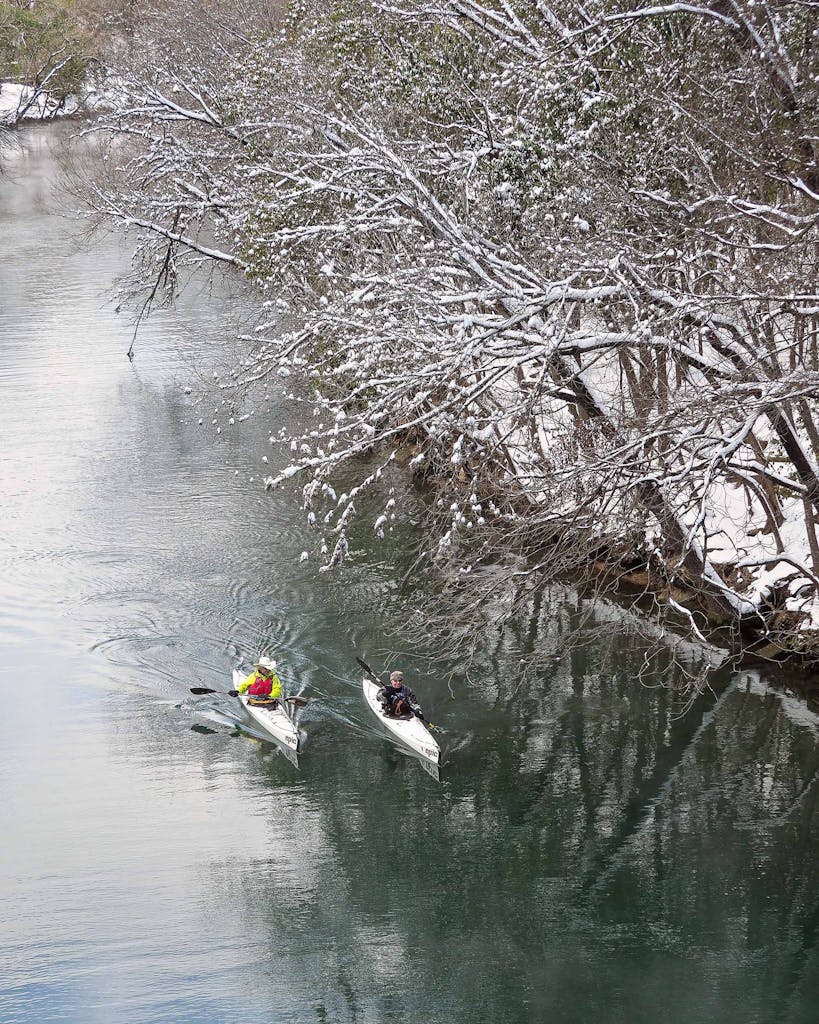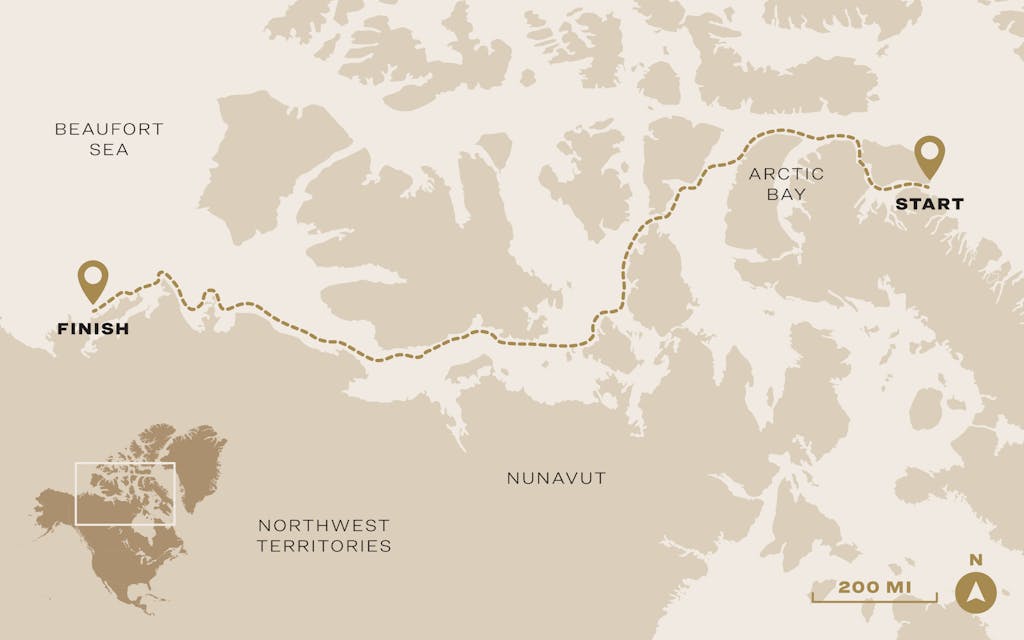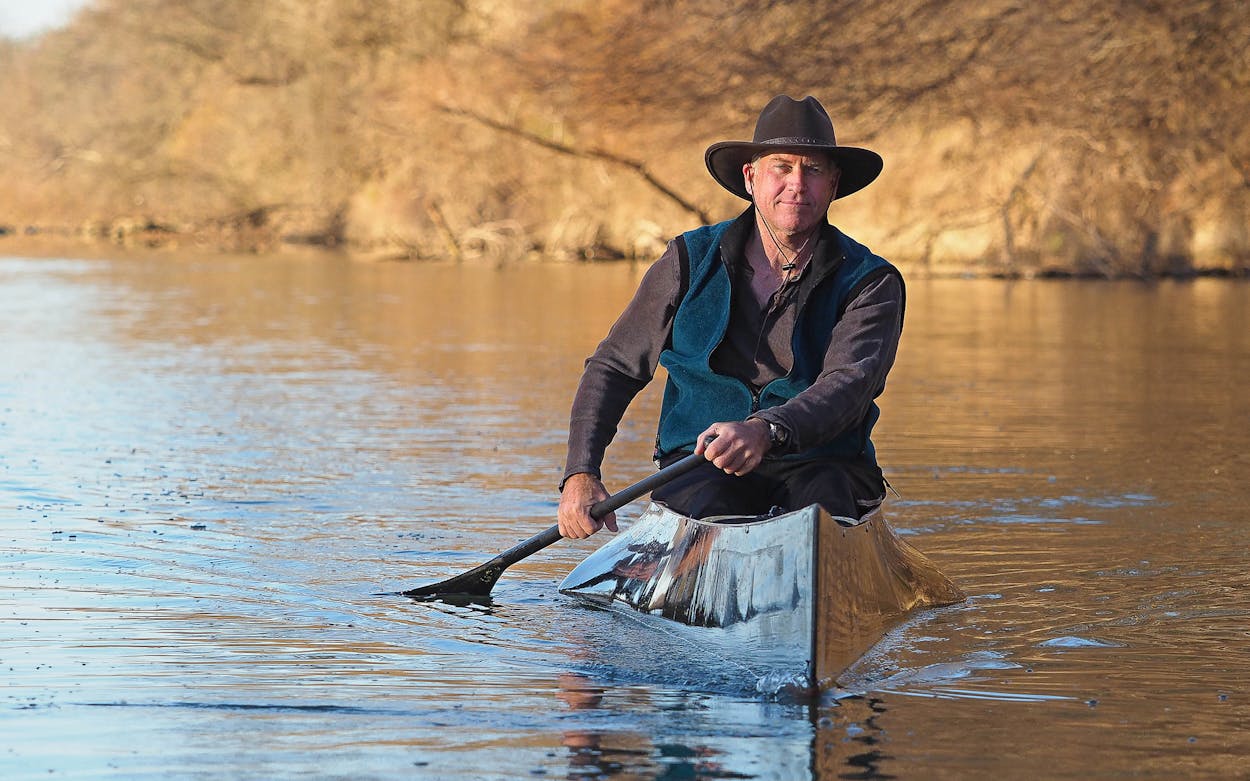When the historic storm of February 2021 dropped more than six inches of snow on parts of Austin, most of the city’s residents hunkered down indoors. Not West Hansen, who loaded a kayak onto his four-wheel-drive pickup and headed slowly and carefully for Lady Bird Lake.
There, he and fellow paddler Jimmy Harvey wrestled nylon dry suits over their long underwear. They attached insulated, oven-mitt-like mittens to their paddles. Then, taking care not to slip in the snow, the men lugged their bullet-shaped sea kayaks to the cold water. The freak storm would provide a rare opportunity to test gear for his upcoming kayaking expedition through the Northwest Passage in the Arctic. The two kayakers spent a few chilly hours on the otherwise deserted water before returning to the boat launch, where a cross-country skier zipped by them as they pulled their boats out of the lake.
Chances are, the temperatures they experienced that day were slightly colder than what Hansen will face this summer, as he paddles through the Canadian Arctic Archipelago, north of mainland Canada. He’s the leader of the Arctic Cowboys, an expedition whose lineup includes two other Texans, Jeff Wueste and Rebekah Feaster. (Harvey had planned to go but dropped out because of a disagreement about the route and the timing of the trip.) The team has been working toward a grueling two-thousand-mile Northwest Passage crossing for about five years, with their plans postponed once by weather and twice by the coronavirus pandemic. Now it looks like the trek is really happening, with a target departure date from Austin of July 15.
Though air temperatures in the Arctic summer, which hover between freezing and somewhere in the 60s, should be manageable, almost every other aspect of the journey will be exceptionally challenging. The paddlers expect to encounter high winds and water temperatures just above freezing. Hypothermia and drowning are serious risks, should anyone have the misfortune to tip over their boat and fall into the sea. And then there’s the local wildlife, which includes orcas and polar bears. The latter can smell prey from up to a kilometer away and can swim as fast as 6 miles per hour. The Arctic Cowboys expect to see the bears every day during their roughly sixty-day journey, hopefully from a safe distance. “Primarily, the wind is the biggest concern. We’re prepared for snow and ice and rain, but the wind will create choppy waves and difficult paddling conditions,” Hansen says.
If anyone is up to the task, it’s Hansen. A veteran endurance paddler, the sixty-year-old longtime Austin resident navigated the 4,200-mile Amazon River from source to sea by kayak in 2012, followed by Russia’s 2,200-mile Volga River two years later. He’s been practicing the sport for about forty years, since he was a psychology major and cheerleader at Southwest Texas State University. Hansen took a whitewater kayaking class there, learning the basics on the Guadalupe River, and promptly got hooked on the adrenaline-fueled sport.

Through other paddlers, he heard about the Texas Water Safari, a 260-mile race from San Marcos to the Texas Coast that is fraught with mud, sleep deprivation, logjams, extreme heat, spiders, man-size alligator gar, and actual alligators. Twenty-one Safari finishes later, he still loves the escape from the cushiness of modern life that endurance paddling delivers, and revels in overcoming the misery (and hallucinations) that come with it.
Then, in 2008, he and some friends went to South America to compete in the Great River Amazon Raft Race. Competitors build a raft out of eight 16-foot logs and paddle 87 miles down the Amazon River. Instead of lashing the logs together side by side, like every other team, Hansen’s group fastened them end to end, creating a long boat reminiscent of the six-person canoes they’d raced in Texas.
They won that race, but Hansen was soon looking for an even bigger challenge. Four years later, in 2012, he and a rotating cast of partners became the first to paddle roughly 4,200 miles from the farthest known source of the Amazon to the sea. (Two years later, he learned that the source was about 4 miles from where he launched, at a different feeder stream.) During that 111-day adventure, sponsored in part by National Geographic, the crew was held at gunpoint five times, discovered floating bales of marijuana, camped, admired pink dolphins, and grappled with homesickness. Hansen, working off notes scratched into a small yellow waterproof notebook, wrote about the experience in his 2019 book, The Amazon From Source to Sea: The Farthest Journey Down the World’s Longest River. Two years later, he and longtime friend Wueste, who had paddled part of the Amazon with him, headed to Russia, where they navigated all 2,200 miles of the Volga River. “West has got that peak-bagging mindset that I think you need to connect all the dots [to do these expeditions],” says Wueste. “I know he’s not going to quit.”
Hansen fits these adventures in around his work as a part-time carpenter. He also commutes to East Texas, where he helps seniors navigate the ins and outs of the medical system as a social worker for the family health-care business Social Systems Inc. As if that weren’t enough, he organizes an annual paddling race, the Texas Winter 100K, on the Colorado River between Austin and Bastrop.
Many of his fellow paddlers admire him, but Hansen is known for his sometimes abrasive personality too. He can be ornery, and doesn’t hesitate to let others know if they haven’t met his high expectations. “I’m intolerant of intolerance,” he says. He plays chess, sips scotch (though he’s abstaining now as he hones his fitness), prides himself on his grilling skills and his perfect lawn, and doesn’t skimp on high-quality coffee and soap. He nearly always carries a notepad and pen in his pocket, where he jots down to-do lists and ideas. Hansen ran unsuccessfully for U.S. Congress in 2018, and he’s a member of the prestigious Explorers Club, whose members include astronauts, mountain climbers, and underwater explorers from around the globe.
Hansen and his wife, Lizet, have one daughter, Isabella, who will track her father’s Arctic journey from Chicago, where she is about to start graduate school. Now 23, Isabella was 13 when her dad started his Amazon expedition high in the snow-covered mountains of the Peruvian Andes; she and Lizet came along as part of the support team for a few weeks. “That was pretty scary initially, and I do remember feeling pretty powerless,” she says, of watching her mother tend to Hansen at the end of a frigid day early in the trip. “I remember stepping away, thinking I couldn’t help him much.” Still, her father’s extreme adventures seemed pretty normal at the time. “It took a while for me to get enough exposure to other people’s parents to realize this was not normal,” Isabella says. “As I’ve gotten older, I’ve had to do a lot of reassuring myself that he can evaluate situations and decide when something is safe.”
Hansen has found himself in a sticky situation more than once, whether it was dodging boulders crashing over the rim of a canyon wall where workers were constructing a dam or looking down the barrel of a gun pointed at him by a river bandit, but so far he’s come out unscathed. “I’m really good at handling difficult situations in the moment and figuring out what needs to happen,” he says. “I’m not good at avoiding difficult situations, and I put myself in those situations unnecessarily.”
In 2020, when the pandemic scuttled the Texas Water Safari and the Northwest Passage trip, he was bored and in need of a distraction. So, that May, Hansen led a small crew of five paddlers (one of whom dropped out along the way) on a thirteen-day journey from the sandy tip of South Padre Island to the refinery-studded Louisiana border. They called it the Third Coast Cowboys Epic Kayak Journey. “It was something to do to break out of our day-to-day routines,” Hansen said at the time. “In that respect, it was just a relaxing trip.”
Here’s what happened on Hansen’s version of a relaxing trip: High winds blew like the world’s biggest box fan, and in the Gulf, the paddlers dipped and rose in swells as big as school buses. They were occasionally pitched into the water. After two days of battling rough chop, they shifted to the more protected Intracoastal Waterway. There, they camped on crab-infested mudflats, endured a storm that collapsed several of their tents, and dodged fast-moving cargo ships while crossing the Galveston Ship Channel. In bustling Galveston Harbor, they paused their sleek 18.5-foot Epic kayaks at Pier 21 and admired the three-masted Elissa, a tall sailing ship launched in 1877, more than 150 years earlier. They also paddled alongside pods of dolphins, pitched tents on small barrier islands covered in lush, lime-colored grass, spent hours pondering riddles and trivia, sang songs in the evenings, and watched serene sunrises and sunsets.
As the team pulled ashore in Port Arthur, finishing their trek after 420 miles, Hansen stepped over a dead fish and greeted a small crowd of family members. “Well, that’s done,” he said, stubble bristling from his chin. “Was there ever a moment you wanted to quit?” someone asked, as the team celebrated with barbecue in the shadow of the Sabine Lake Causeway Bridge. “Yeah, every one,” Hansen joked, his nose sunburned and patches of skin on his lower back rubbed raw by his kayak seat.
The next summer, in September 2021, Hansen headed to Alabama, where he raced 650 miles down the spine of the state, winning the men’s solo division of the Great Alabama 650, dubbed “The World’s Longest Annual Paddle Race.” But these stateside expeditions were small potatoes for Hansen, who had been dreaming about a Northwest Passage expedition for five years.
If he and his crew complete the route this summer, it will mark the first kayak or rowing crossing of the remote, 2,200-mile passage through the Canadian Arctic Archipelago. The first recorded navigation of the Northwest Passage took place in 1906, when Roald Amundsen sailed through on the ship Gjoa. It took 38 years before a Royal Canadian Mounted Police schooner, St. Roch, made the second navigation. Since then, more ships and even sailboats have navigated the passage. But no one has ever kayaked or rowed the entire route, primarily because it’s been blocked by ice—which is now melting as the planet warms. It’s bittersweet that climate change has made this incredible feat possible. “It’s one of the rare firsts that hasn’t been done,” Hansen says. “Right now it’s just a goat path, and we’re going to paddle it before it becomes a superhighway.” Two other expeditions will attempt similar crossings this year. Leven Brown of Scotland will lead a team of two eight-person boats that will attempt to row through the Northwest Passage, in the same direction as the Arctic Cowboys, and American Karl Kruger will attempt to paddle a stand-up paddleboard through it, heading the opposite way.

Hansen’s team plans to launch from Baffin Bay, near Pond Inlet in Nunavut, Canada, and then paddle southwest, reaching the tiny Inuit community of Tuktoyaktuk roughly two months later.
“We’re looking at averaging thirty-eight miles a day, which I think is doable and conservative,” he says. Though paddling kayaks through this notoriously choppy, frigid ocean route is clearly a kind of madness, it comes with advantages too. As Hansen points out, kayaks are nimble in ways that bigger boats aren’t.
“We can paddle our kayaks in six inches of water near the shore where there’s no drift ice, or through thin ice leads,” he says. “We can maneuver fast, we can paddle in wind, haul our boats on shore, and camp. We’ve prepared for it.” About two weeks in, they’ll reach the Bellot Strait, a narrow, eighteen-mile-long, often foggy, cliff-lined channel with a high concentration of polar bears. “No one has ever kayaked through that strait,” he says. “It’s remote, hard to get to, and water rushes through every four hours at about 9.5 miles per hour or higher.”
It’s also windy, and water temperatures in the strait hover between the 20s and 40s. Team members will need to stay close together so they can help one another in case of emergency.
They’ll sleep in tents, and in areas frequented by polar bears they’ll sleep in shifts—which might not feel quite as strange as it sounds, since the sun never sets during the Arctic summer.
The self-funded trip will cost an estimated $45,000. The team expects to finish by end of September or first week of October. “If we get within barn-smelling distance, we’re going to finish,” Hansen says.
He says his age carries advantages as well as disadvantages. “We know how hard we can push ourselves, and we’re probably less hot-headed than we were in our twenties,” he says. “We’re not as strong, we’re not as fast, we’re not as limber. But we’re more tolerant, we have a higher threshold for emotional and physical discomfort, and hopefully can work out the inevitable problems that come up during an expedition.”
Hansen sounds characteristically nonchalant about it all. “It’s nice to get into the rhythm, to exist, and at the end of day be tired and sleep well,” he says. He’s looking forward to the chance to “just paddle and enjoy the company of the people I’m with.”
- More About:
- Austin






